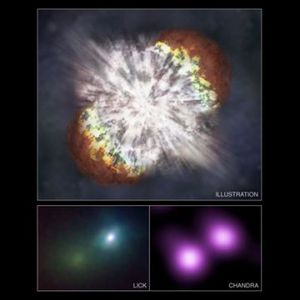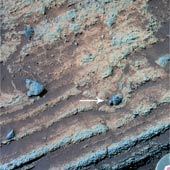The brightest stellar explosion ever recorded may be a long-sought new type of supernova, according to observations by NASA's Chandra X-ray Observatory and ground-based optical telescopes. This discovery indicates that violent explosions of extremely massive stars were relatively common in the early universe,
and that a similar explosion may be ready to go off in our own Galaxy.

|
| ©Credit: Illustration: NASA/CXC/M.Weiss; X-ray: NASA/CXC/UC Berkeley/N.Smith et al.; IR: Lick/UC Berkeley/J.Bloom & C.Hansen
|
| The brightest stellar explosion ever recorded may be a long-sought new type of supernova, according to observations by NASA's Chandra X-ray Observatory and ground-based optical telescopes. This discovery indicates that violent explosions of extremely massive stars were relatively common in the early universe, and that a similar explosion may be ready to go off in our own Galaxy.
|
Comment: Eh....another similar type of explosion "may be about to go off in our own galaxy"? Anyone want to comment on the possible effects on planet earth and its inhabitants?
Food safety experts have advised parents to eliminate a series of additives from their children's diet while they await the publication of a new study that is understood to link these ingredients to behaviour problems in youngsters.
A mysterious area of layered bedrock on Mars that has puzzled scientists was formed by a volcanic explosion, new research shows.

|
| ©Image Science
|
| A false-color image taken by the Mars rover Spirit shows a small rock "bomb" (indicated with arrow) and the impact "sag" it made in the Martian surface. The bomb is about 1.6 inches (4 centimeters) wide. Scientists say the rock may have been jettisoned by a volcanic eruption, leaving what one researcher called the first "powerful evidence of explosive materials" on Mars.
|
The Israel Museum unveiled a unique 2,200-year-old stele (inscribed stone block) on May 3 that provides new insight into the dramatic story of Heliodorus and the Temple in Jerusalem, as related in the Second Book of Maccabees.
"The Heliodorus stele is one of the most important and revealing Hellenistic inscriptions from Israel," said James S. Snyder, Anne and Jerome Fisher Director of the Israel Museum.
"It contextualizes the Second Book of Maccabees and provides an independent and authentic source for an important episode in the history leading up to the Maccabean Revolt, whose victorious conclusion is celebrated each year during the Jewish festival of Hanukkah."
The seeds of a sunflower, the spines of a cactus, and the bracts of a pine cone all grow in whirling spiral patterns. Remarkable for their complexity and beauty, they also show consistent mathematical patterns that scientists have been striving to understand.
A surprising number of plants have spiral patterns in which each leaf, seed, or other structure follows the next at a particular angle called the golden angle. The golden angle is about 137.5º. Two radii of a circle C form the golden angle if they divide the circle into two areas A and B so that A/B = B/C.
Chimpanzees and bonobos can communicate with greater flexibility using hand gestures than they can with facial expressions or vocalizations, new research shows. Their use of hand motions to convey different meanings in different circumstances suggests that gestures may have played an important part in the evolution of language.
Researchers speculate about how prehuman species developed the capacity for complex language. One theory suggests that humans' apelike ancestors first communicated through gestures. Once the neural circuits for gesture-based language had evolved, those same brain areas could have switched over to verbal communication. Indeed, research has shown that modern apes use the same area of the brain to interpret hand signals as humans use to process spoken language.
Working at the Yerkes National Primate Research Center in Atlanta, Frans B.M. de Waal and Amy S. Pollick observed communications among 34 captive chimpanzees and among 13 captive bonobos, also known as pygmy chimpanzees. The researchers logged every hand gesture, facial expression, and vocal cry that one animal directed at another. They also noted the social context - playing, grooming, fighting, having sex, eating, and so on - in which each signal occurred.
With temperatures ranging from 1000 to 2000°C, gravity 15 times stronger than Earth's, and a year that lasts just 5.6 of our days, HAT-P-2b is not a planet you'd want to visit for vacation.
The unusual gas giant - located 440 light-years away in the constellation Hercules - turns out to be the most massive planet found outside our solar system so far.
Astronomers at the Harvard-Smithsonian Center for Astrophysics in Cambridge, Massachusetts, spotted the superdense planet using the HATNet global network of automated telescopes, which scans a large fraction of the Northern Hemisphere sky every night to search for planets.
HAT-P-2b, the second planet the project has discovered, stunned scientists with far-out features unprecedented for an alien world.
NASA has released stunning new images of Jupiter and its moons taken by the New Horizons spacecraft. Views include a movie of a volcanic eruption on Jupiter's moon Io; a nighttime shot of auroras and lava on Io; a color photo of the "Little Red Spot" churning in Jupiter's cloudtops; images of small moons herding dust and boulders through Jupiter's faint rings--and much more: gallery.
"We'll be analyzing these data for months to come," says Science Mission Directorate Associate Administrator and New Horizons Principal Investigator Alan Stern of NASA Headquarters. "We have collected spectacular scientific products as well as evocative images."
New Horizons came within 1.4 million miles of Jupiter on Feb. 28 in a gravity assist maneuver designed to trim three years off its travel time to Pluto. For several weeks before and after this closest approach, the piano-sized robotic probe trained its seven cameras and sensors on Jupiter and its four largest moons, storing data from nearly 700 observations on its digital recorders and gradually sending that information back to Earth. About 70 percent of the expected 34 gigabits of data has come back so far, radioed to NASA's largest antennas over more than 600 million miles.
BBCSun, 06 May 2007 00:03 UTC
US researchers carrying out a sonar survey of Loch Ness have been amazed to find a common toad crawling in the mud 324ft (98m) down.
Researchers working with high-precision planetary radars, including the Goldstone Solar System Radar of NASA's Jet Propulsion Laboratory, Pasadena, Calif., have discovered strong evidence that the planet Mercury has a molten core. The finding explains a more than three-decade old planetary mystery that began with the flight of JPL's Mariner 10 spacecraft. The research appears in this week's issue of the journal Science.
Comment: Eh....another similar type of explosion "may be about to go off in our own galaxy"? Anyone want to comment on the possible effects on planet earth and its inhabitants?